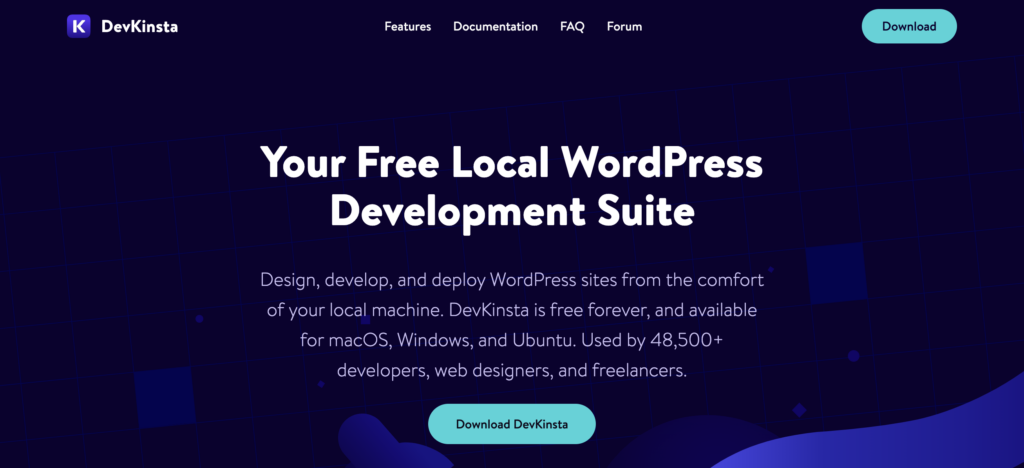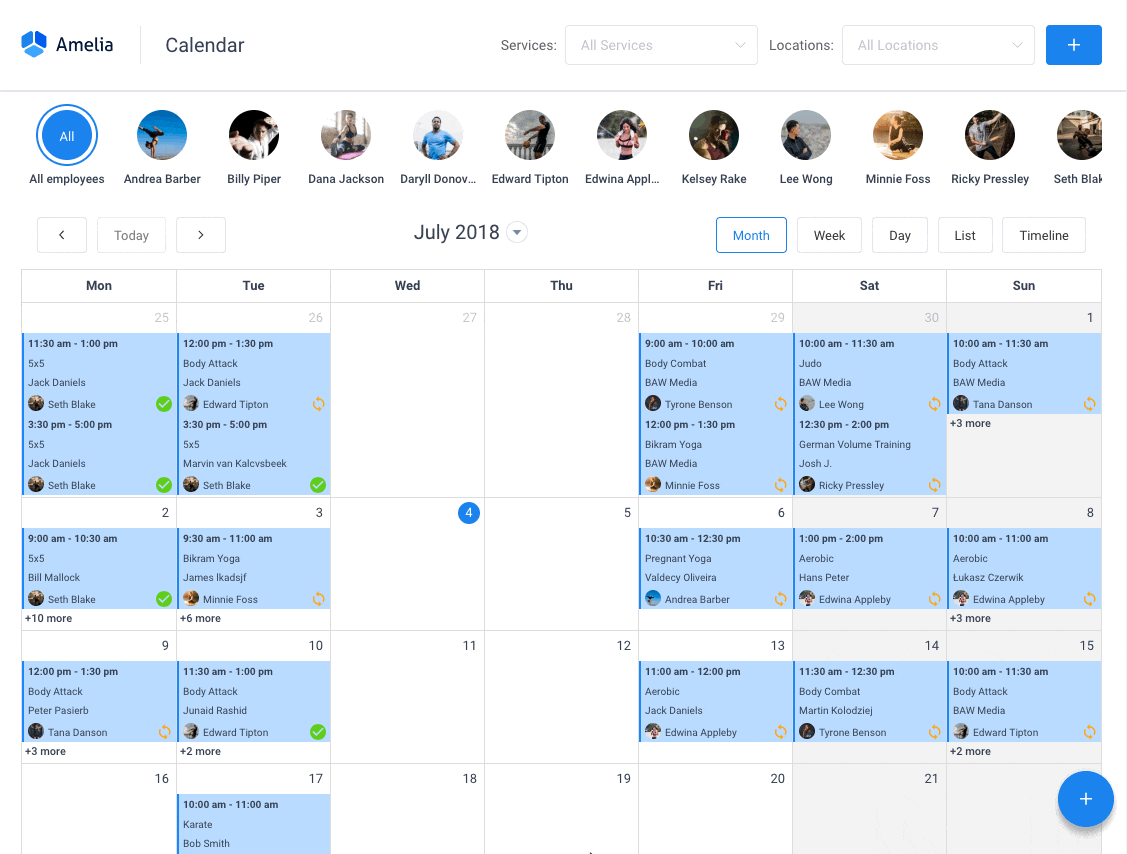Developing a WordPress website can be an exciting journey, but it often requires a safe and efficient environment where you can experiment, test, and perfect your ideas before taking them live. That’s where local WordPress development tools come into play.
In this article, we’ll explore the world of local WordPress development environments and help you discover the best tools to streamline your WordPress development process.
What is a local WordPress development environment?
A local WordPress development environment is a self-contained setup on your computer that simulates a live web server. It allows you to work on your WordPress website without the need for an internet connection.
In essence, it’s a private sandbox where you can build, design, and test your website in a controlled environment. You can fine-tune every aspect of your WordPress projects, from themes and plugins to custom code, without the need for an active internet connection. Conducting proper WordPress testing during this phase ensures that your site functions flawlessly before it ever goes live.
A local WordPress development environment replicates the core components of a typical web server, such as web server software (e.g., Apache or Nginx), a database management system (e.g., MySQL or MariaDB), and the scripting language (e.g., PHP) that WordPress relies on. These elements work together seamlessly on your local machine to deliver the same functionality as a live server. And that’s what allows you to preview and test your website’s functionality, design, and features with utmost precision.
Why Do You Need a Local Development Environment?
Why is this level of simulation so crucial for web development, particularly when working with WordPress? The answer lies in several key advantages:
1. Speed and efficiency
A local development environment significantly speeds up the development process. Since your computer handles all the processing locally, web pages load faster, and code changes are instantly visible. This speed comes in very handy when you need to go over designs, test new features, or troubleshoot issues efficiently.
2. Security
In addition, local environments provide a safe and secure testing ground. You can experiment with code, themes, and plugins without risking the integrity or security of your live website. This isolation minimizes the chances of accidentally introducing bugs, conflicts, or vulnerabilities into your production site.
3. Offline development
What’s more, with a local development environment, you don’t need an internet connection. This means you can work on your WordPress projects regardless of whether you’re connected to the web or not. Internet interruptions or slow connections will no longer disrupt your workflow. The result? Uninterrupted development sessions.
How to Choose the Best Local WordPress Development Tool for You?
Before we dive into the best local WordPress development environment solutions, let’s discuss some factors to consider when making your choice.
- Compatibility: Ensure the tool you choose is compatible with your operating system (Windows, macOS, or Linux).
- Ease of Use: Look for user-friendly interfaces and features that match your skill level.
- Scalability: Consider your future needs. Will the tool accommodate larger projects and more complex configurations?
- Community Support: Tools with active user communities often have more resources, tutorials, and troubleshooting assistance available.
- Performance: Check the tool’s performance, including speed and resource consumption, to ensure it meets your requirements.
Now, let’s explore the top 10 local WordPress development environments.
10 Best Local WordPress Development Environment Solutions
1. DevKinsta: A robust and user-friendly local WordPress development tool by Kinsta
DevKinsta is a sophisticated and specialized local WordPress development environment, designed to cater to the needs of WordPress developers and enthusiasts. It’s a product of Kinsta, a renowned premium managed WordPress hosting provider known for its commitment to speed, security, and developer-friendly features.
DevKinsta is a cross-platform tool powered by Docker and compatible with Windows, macOS, and Ubuntu. It offers a comprehensive development stack, including a Nginx web server, Adminer database management, and PHP support. One standout feature is its built-in SSL support, which ensures that your local WordPress projects can be developed securely.
Key features
- Quick WordPress Installation: DevKinsta simplifies the process of setting up a WordPress site locally. With just a few clicks, you get a ready-to-use WordPress website with multisite and WP-CLI support.
- WordPress Error Logging: with a built-in WP_DEBUG toggle to debug PHP errors.
- Database Management: With Adminer, you can easily edit database tables, import and export backups, run SQL queries, etc.
- Local Email Management: An SMTP server and email inbox enable you to test and debug outgoing emails from the local WordPress site.
- Easy Site Cloning and Backups: DevKinsta allows you to clone existing websites or create backups effortlessly. This feature is invaluable when you need to test new plugins or themes without risking your production site.
- Integration with MyKinsta: For Kinsta hosting customers, DevKinsta seamlessly integrates with MyKinsta, Kinsta’s hosting control panel. This means you can easily deploy your locally developed sites to Kinsta’s hosting environment when they’re ready to go live.
Pros
- User-Friendly Interface: DevKinsta boasts an intuitive and user-friendly interface, therefore, it’s accessible even to developers with limited experience.
- Excellent Support from Kinsta: As a product of Kinsta, DevKinsta benefits from the same high-quality customer support and expertise that Kinsta is known for. Also, you get access to a support forum with WordPress experts to assist.
- SSL Support for Secure Development: DevKinsta’s built-in SSL support ensures that you can develop your local WordPress projects with the highest level of security.
- Available in 10 languages: English, French, Spanish, Portuguese, Dutch, German, Italian, Japanese, Swedish, and Danish.
Cons
- Limited to WordPress Development: DevKinsta is primarily tailored for WordPress development. So, if you’re working on non-WordPress projects, you may find other tools more versatile.
Ease of use
DevKinsta prioritizes ease of use with a straightforward setup process and an intuitive interface, making it an excellent choice for developers of all levels.
Price
The best part about DevKinsta is that it’s completely free to use. This makes it an attractive option for WordPress developers looking for a powerful and reliable local development environment without breaking the bank.
2. XAMPP: A versatile and open-source local development environment for web developers
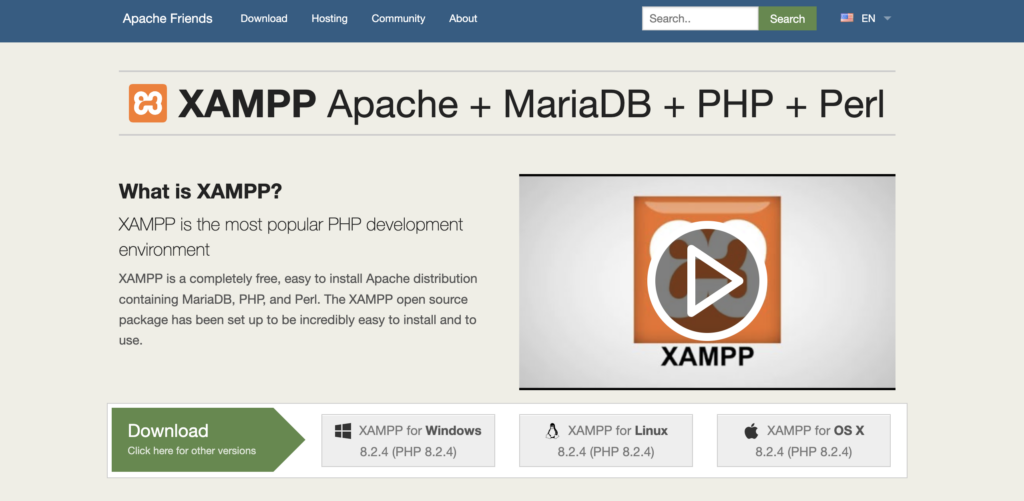
XAMPP, which stands for Cross-Platform (X), Apache (A), MariaDB (M), PHP (P), and Perl (P), is a widely used open-source local development environment that offers a comprehensive suite of web server technologies. It is a versatile tool that caters to a broad range of web development needs and has gained popularity among developers worldwide.
Key features
- Easy Installation and Configuration: One of XAMPP’s strengths is its straightforward installation process. Setting up a local environment for WordPress development is a breeze.
- Cross-platform: Compatible with Windows, macOS, and Linux.
- Possible VM-based Local WordPress Experience: If you download a suitable macOS version of XAMPP, you can enjoy the full Virtual Machine experience.
Pros
- Versatile for Various Web Development Projects: XAMPP’s support for multiple technologies makes it suitable for a wide array of web development projects, beyond just WordPress.
- Extensive Documentation Available: The tool benefits from extensive documentation, tutorials, and user guides. This makes it easier for developers to get started and troubleshoot common problems.
Cons
- Manual Configuration May Be Required: While the initial setup is user-friendly, XAMPP is not designed exclusively for CMS. This means that certain WordPress configurations may require manual adjustments, which could be challenging for beginners.
- Overwhelming for Beginners: Despite its user-friendliness, the abundance of features and customization options might feel overwhelming for developers who are new to web development environments.
Ease of use
Despite its many great features, the ease of use is definitely not what got XAMPP on our list of the best local WordPress development environments. Not only can the initial installation and setup be challenging, but the toll also lacks an intuitive interface.
Price
XAMPP is open-source and entirely free, so it’s an attractive choice for budget-conscious developers who seek a powerful and flexible local development environment.
3. MAMP: A macOS-centric environment for WordPress enthusiasts
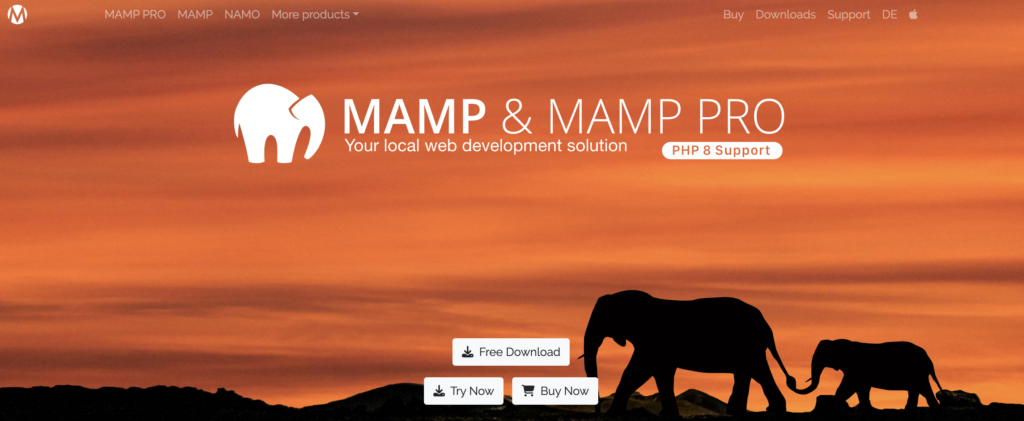
MAMP, short for “My Apache, MySQL, and PHP” is a dedicated local development environment tailored for macOS and Windows users. It’s specifically designed to simplify the process of setting up and managing a local web server.
MAMP provides its users with a complete web development stack that includes the Apache or Nginx web server, MySQL database management system, and the PHP, Python, Ruby, and Perl programming languages.
Key features
- Quick Installation of WordPress: MAMP streamlines the installation of WordPress on your local machine. Within minutes, you can have a fully functional WordPress environment ready for development.
- Different Components and PHP Releases: MAMP comes equipped with a variety of components. These include MAMP Cloud, APC, eAccelerator, XCache and OPcache, Apache, Nginx, and different PHP versions.
- User-Friendly Dashboard: MAMP provides an intuitive dashboard where you can manage your web server, databases, and PHP configurations. This dashboard simplifies tasks such as starting and stopping your local server, adjusting PHP versions, and managing databases.
Pros
- Manual Setup: As it doesn’t have separate installers for WordPress, MAMP is ideal for those who like to get their hands dirty and set up their website manually.
- Intuitive Interface: The user-friendly dashboard makes MAMP accessible to developers of varying skill levels, including those who are new to web development environments.
- Solid Performance: MAMP offers stable and reliable performance on macOS, ensuring that your WordPress development process runs smoothly.
Cons
- Tailored to macOS Users: Although MAMP supports Windows, this local environment is clearly optimized and tailored to macOS. This means that, although it ensures seamless integration and performance on Apple’s hardware, Windows users tend to notice a lack of functionalities.
- Free Version Limitations: While MAMP offers a free version with essential features, more advanced functionality may require upgrading to the paid MAMP Pro version.
Ease of use
MAMP’s user-friendly interface, fewer dashboard options, and macOS optimization make it an excellent choice for macOS users seeking a hassle-free local development environment.
Price
MAMP offers both a free version and a paid MAMP Pro version with additional features. The free version is suitable for basic WordPress development needs.
4. LAMP: A powerful and customizable solution for Linux enthusiasts

Image by pch.vector on Freepik
LAMP, which stands for “Linux, Apache, MySQL, PHP,” represents a robust software stack tailored primarily to Linux users. It’s designed to empower Linux enthusiasts and developers with a customizable, open-source stack that forms the foundation for developing and testing WordPress websites and a wide range of other web applications.
Key features
- Customizable: LAMP is completely customizable, allowing users to configure and adapt the environment to meet specific project requirements.
- Ideal for Linux-Based Hosting Environments: LAMP is particularly well-suited for developers who plan to host their WordPress sites on Linux-based servers. This local environment closely mirrors Linux server configurations, providing an authentic development experience.
Pros
- High Level of Control: Developers using LAMP have the advantage of fine-grained control over the components of their local development stack. This makes it a great choice for those who want to experiment with different configurations.
- Cost-Effective and Open-Source: LAMP is open-source and free, making it a cost-effective choice for budget-conscious developers.
Cons
- May Require More Technical Expertise: The flexibility and customizability of LAMP mean that it may be more suitable for developers with a moderate level of technical expertise.
- Linux-Only Compatibility: LAMP is optimized for Linux environments, limiting its compatibility to Linux users.
Ease of use
LAMP is powerful but may require more technical expertise compared to some other tools. It’s best suited for developers comfortable with Linux and server configurations.
Price
LAMP is open-source and entirely free, making it an accessible option for Linux users seeking a highly customizable and Linux-compatible local development environment.
5. WampServer: A Windows-focused and versatile local development environment
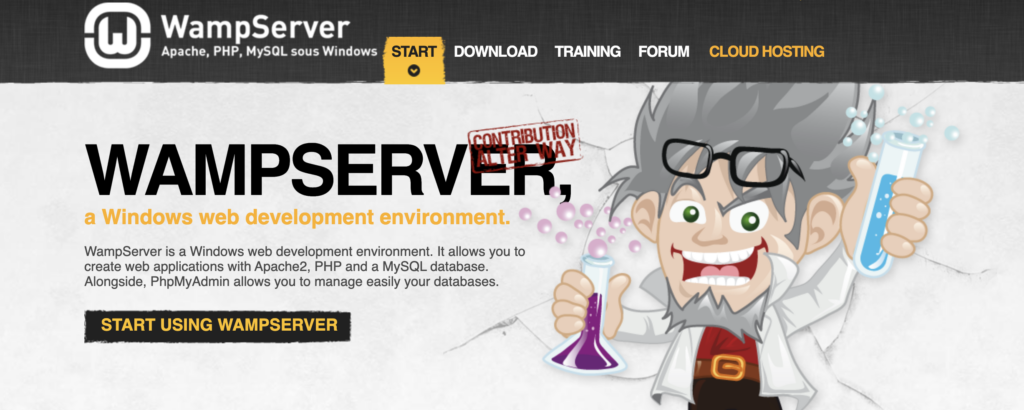
WampServer is a dedicated local development environment primarily designed for Windows users. It stands as a versatile and user-friendly solution that streamlines the process of setting up a local web server environment on Windows machines. With a focus on simplicity and functionality, WampServer has gained popularity among Windows-based web developers.
Key features
- Quick and Easy Installation: WampServer has a pretty straightforward installation process. Within minutes, Windows users can have a fully functional local web server environment, ready to host WordPress websites and other web applications.
- Key Components: WampServer combines key components of a web server stack, including the Apache web server, MySQL database management system, and PHP scripting language.
- User-Friendly Interface: With an intuitive and user-friendly interface, WampServer simplifies the management of your local development environment. This lightweight solution provides a control panel where you can start and stop your server, configure settings, and manage databases effortlessly.
Pros
- Suitable for Beginners: The tool’s user-friendly installation and setup process make it accessible to developers of varying skill levels, including beginners.
- Support for Multiple PHP Versions: WampServer allows developers to switch between different PHP versions, making it versatile for projects that may require specific PHP configurations or compatibility.
Cons
- Limited to Windows Users: WampServer’s compatibility is limited to Windows-based operating systems, which may exclude users of other platforms.
- Occasional Compatibility Issues: While generally user-friendly, some users have reported occasional compatibility issues with specific software configurations.
Ease of use
WampServer is known for its user-friendly interface, especially during the initial installation and setup. It’s an excellent choice for Windows users looking for a hassle-free local development environment.
Price
WampServer is open-source and entirely free, so it’s an attractive option for Windows-based developers seeking a versatile and straightforward local development environment.
6. Local by Flywheel: A cross-platform powerhouse for WordPress development
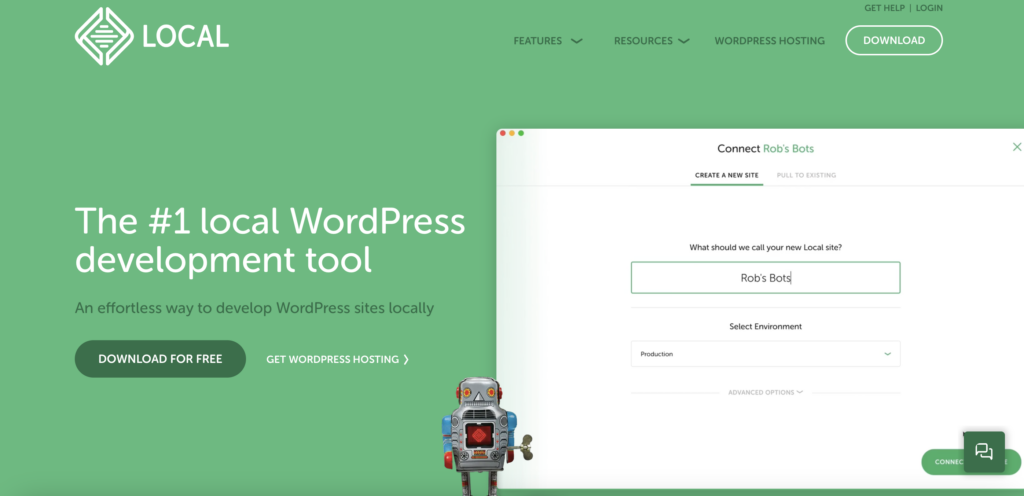
Local by Flywheel is a versatile and powerful local WordPress development environment created by Flywheel, a well-respected WordPress hosting provider. It caters to the needs of modern developers, offering a feature-rich and user-friendly platform for creating, testing, and optimizing WordPress websites. With cross-platform compatibility, it’s a top choice for developers across various operating systems.
Key features
- User-Friendly Interface: Local by Flywheel is celebrated for its intuitive and user-friendly interface. The streamlined design simplifies the setup process, making it accessible to developers of all levels, from beginners to experts.
- Integration with Hosting Providers: For users who plan to host their websites with specific hosting providers like Flywheel, Local integrates seamlessly with those services, simplifying the deployment process.
- Advanced Development Features: Local comes with root SSH access and WP-CLI, as well as some useful pre-launch tools.
Pros
- Cross-Platform Compatibility: Local is designed to work on Windows, macOS, and Linux, ensuring that developers across various operating systems can benefit from its features.
- Active Community Support: The Local by Flywheel community is thriving, offering ample resources, tutorials, and troubleshooting assistance for users.
- Built-in SSL Support: Security is a top priority, and Local includes built-in SSL support, allowing you to develop WordPress projects with the highest level of security.
Cons
- Consumes a Lot of Memory: The software download size may not be suitable for anyone running low on space.
- May Not Be as Easy to Set Up as Some Other Tools: Regardless of the operating system you use, Local can be challenging to set up.
Ease of use
Local’s user-friendly interface makes it accessible to developers of all levels. Its straightforward setup process and modern design make it an excellent choice for WordPress development.
Price
Local offers both a free version, which is suitable for most WordPress development needs.
7. Vagrant: A highly customizable and scalable local development environment manager
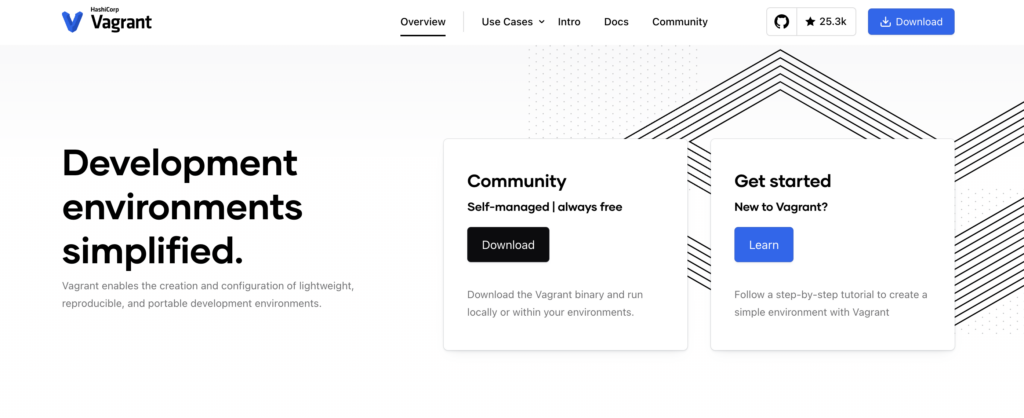
Vagrant is a versatile and powerful local development environment manager that empowers developers to create, configure, and manage virtualized development environments effortlessly. It’s an ideal choice for those who prefer a high degree of customization and scalability in their development setups.
Vagrant doesn’t provide a specific web server or database management system. Instead, it acts as a manager for virtual machines that can be provisioned with various configurations. Developers can choose their desired virtualization provider, such as VirtualBox, VMware, or others, to create virtualized development environments. Moreover, Vagrant is compatible with Windows, macOS, and Linux, offering cross-platform flexibility.
Key features
- Versatile for Various Development Setups: Vagrant is not limited to a single web development stack, making it highly versatile. Developers can configure virtual machines with different operating systems, web servers, and databases to match their specific project requirements.
- Supports Multiple Virtual Machine Providers: Vagrant supports various virtual machine providers, allowing users to choose the one that best suits their needs. This flexibility is especially valuable for developers with existing virtualization solutions.
- Command-Line Interface for Advanced Users: Vagrant provides a command-line interface (CLI) that caters to advanced users who are comfortable with command-line interactions. This CLI allows for precise control over the provisioning and management of virtual environments.
Pros
- Highly Customizable: Vagrant’s customization options are extensive, enabling developers to create virtual environments tailored precisely to their project’s needs.
- Ideal for Complex Development Setups: Vagrant shines when it comes to complex development setups, including projects involving multiple virtual machines and intricate network configurations.
- Supports Team Collaboration: This solution allows you to reproduce exact machine configurations with the help of its easily shareable environment configuration files. This makes it possible to create a collaborative WordPress development in which every coworker has access to the same virtual hardware.
Cons
- May Have a Steeper Learning Curve: Due to its extensive customization options and command-line interface, Vagrant may have a steeper learning curve, particularly for developers new to virtualization.
- Requires Some Command-Line Expertise: Users comfortable with command-line interactions will find Vagrant more accessible, while those less experienced may need some time to adapt.
Ease of use
Vagrant is great for developers comfortable with command-line interfaces and virtualization. While it offers a high degree of customization, it may have a learning curve for beginners.
Price
Vagrant is open-source and free to use. However, users may encounter costs associated with the virtualization provider and additional plugins or configurations.
8. Instant WP: A lightweight and effortless solution for beginners and streamlined projects
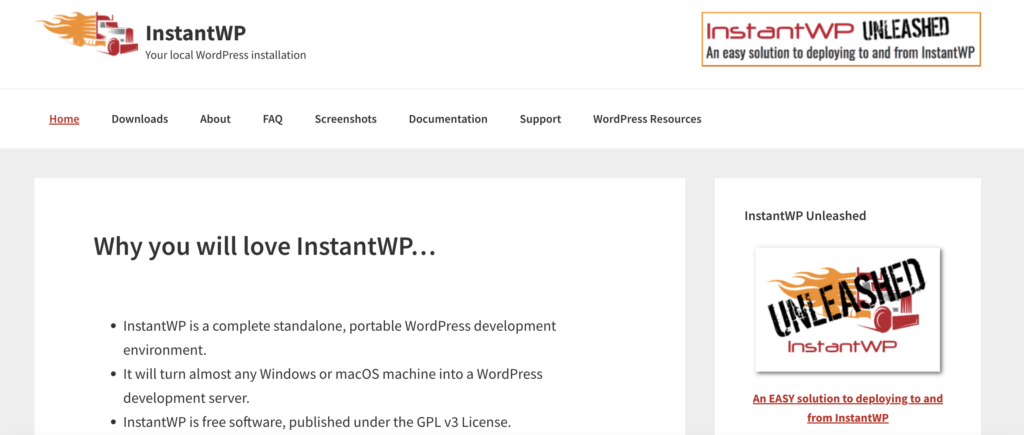
Instant WP is a straightforward and minimalistic local WordPress development environment designed with simplicity in mind. It caters to beginners and developers seeking a hassle-free way to set up a basic local environment for WordPress development. With a focus on ease of use, Instant WP offers a quick and uncomplicated way to create and test WordPress websites.
Key features
- Effortless Installation: Instant WP lives up to its name by offering an exceptionally easy and quick installation process.
- Lightweight and Minimalistic: The tool is intentionally lightweight and minimalistic, focusing on the essentials needed for basic WordPress development. This simplicity ensures that the environment doesn’t overwhelm users with unnecessary features.
- No Need for Additional Configuration: Instant WP comes preconfigured for WordPress, eliminating the need for users to tweak settings or perform additional setup tasks.
Pros
- Extremely Easy for Beginners: Instant WP’s user-friendly design is perfect for beginners who want to get started with WordPress development without the complexities of advanced environments.
- Fast: Due to its minimalistic nature, Instant WP runs efficiently and doesn’t consume excessive system resources.
Cons
- Limited Customization Options: Instant WP’s simplicity comes at the cost of limited customization. This means that it may not be suitable for developers with advanced or specific development requirements.
- Not Suitable for Advanced Development Needs: While excellent for basic WordPress projects, Instant WP may lack the features and flexibility needed for complex or advanced development tasks.
Ease of use
Instant WP excels in terms of ease of use, so it’s an excellent choice for beginners and developers working on straightforward WordPress projects.
Price
Instant WP is free to use, making it an accessible and budget-friendly option for those looking for a no-frills local development environment for WordPress.
9. Docker: A containerization powerhouse for developers seeking scalability and efficiency
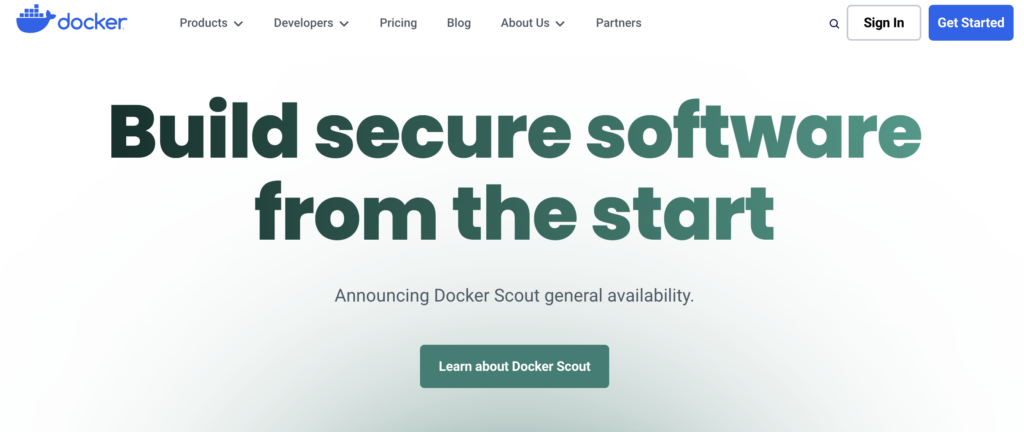
Docker is a cutting-edge containerization platform that offers developers a highly scalable and efficient approach to local WordPress development. It is designed for developers who require a dynamic and reproducible environment that can handle complex development setups and microservices architectures with ease. Thanks to its ability to containerize applications and their dependencies, Docker has gained immense popularity in the tech industry.
Docker utilizes container technology, allowing developers to encapsulate applications, services, and their dependencies within isolated containers. These containers are lightweight and can be deployed consistently across various environments. This ensures that your local development environment closely mirrors your production setup. Docker is platform-agnostic and you can use it on Windows, macOS, and Linux.
Key features
- Portability and Scalability: Docker containers are highly portable and can be easily moved between development, testing, and production environments. This portability simplifies collaboration among teams and ensures consistent results across different stages of development.
- Ideal for Microservices Architecture: Docker’s containerization approach aligns seamlessly with the microservices architecture, enabling developers to build, test, and deploy individual components or services independently. This flexibility is invaluable for complex web projects.
- Extensive Library of Pre-Built Containers: Docker boasts a vast ecosystem of pre-built containers available on Docker Hub. Developers can access ready-made containers for various services, databases, and CMS platforms, including WordPress, streamlining the development process.
Pros
- Highly Scalable and Flexible: Docker is known for its scalability, so it’s an excellent choice for projects with complex multi-container setups or microservices architectures.
- Supports Complex Development Scenarios: Docker’s containerization approach is suitable for a wide range of development scenarios, from simple WordPress sites to intricate web applications.
- Widely Used in Enterprise-Level Development: Docker is a staple in enterprise-level development, meaning that developers who gain expertise with Docker can find themselves well-prepared for career opportunities in large organizations.
Cons
- Requires Familiarity with Container Technology: While Docker is powerful, it may require a learning curve for developers new to containerization concepts.
- May Be Overkill for Simple WordPress Projects: For basic WordPress sites, Docker’s robust capabilities may be more than necessary, making it more suitable for complex or larger projects.
Ease of use
Docker is powerful but may require some learning if you’re new to containerization. However, the investment in learning Docker is often rewarded with increased development efficiency and scalability.
Price
Docker offers a free plan with core features, while paid plans are available for organizations requiring additional features, security, and support.
10. Laragon: A Windows-Focused Local WordPress Development Environment

Laragon is a local development environment explicitly designed for Windows users. It simplifies the process of setting up and managing WordPress and web development projects. Laragon stands out for its speed and ease of use, so it’s perfect for developers looking for an efficient and hassle-free environment for WordPress development.
Key features
- Several Database Management Systems: Laragon comes with MySQL, MariaDB, PostgreSQL, and MongoDB.
- Containerized and Portable: With this tool, you can set up isolated, portable, and highly customizable environments.
- Central Management Dashboard: Use the dashboard to configure and access all the elements of your local WordPress website within minutes.
Pros
- Fast and Lightweight: Laragon requires less than 4MB RAM to run and it’s an incredibly fast and high-performance solution.
- User-Friendly Interface: The tool features an intuitive and user-friendly interface, catering to developers of varying skill levels, including those who are new to web development environments.
- Great for Beginners: Laragon’s one-click WordPress setup simplifies the process of creating and managing WordPress projects, making it accessible for beginners.
Cons
- Limited to Windows Users: Laragon’s compatibility is limited to Windows-based operating systems, potentially excluding users of other platforms.
Ease of use
Laragon’s user-friendly interface and Windows optimization make it an excellent choice for Windows users seeking a straightforward and efficient local development environment for WordPress and web development.
Price
Laragon is open-source and entirely free to use, making it a cost-effective option for Windows-based developers seeking an accessible and streamlined local development environment.
Amelia: Enhancing WordPress with Appointment Scheduling
Businesses across various industries increasingly rely on appointment scheduling and booking systems to manage their services efficiently.
Whether you are designing a website for a healthcare practice, a fitness center, a beauty salon, or any service-oriented business, providing a seamless and user-friendly way for clients to schedule appointments is paramount.
That’s where Amelia comes into play.
Why Amelia:
- Streamlined WordPress Booking Solution: Amelia is a feature-rich booking plugin designed to work with WordPress hassle-free, so it’s a valuable asset for developers looking to create and fine-tune websites that depend on appointment scheduling features.
- Tailored Solution for Appointment-Based Businesses: One of Amelia’s primary strengths is its adaptability to a wide range of business needs. This flexibility allows you to configure and customize scheduling functionalities to align perfectly with specific business requirements.
- User-Friendly Configuration: Amelia’s user-friendly interface simplifies the process of configuring appointment booking features. Developers can easily set up availability schedules, define service offerings, manage employee or service provider profiles, and customize booking forms.
- Extensive Support and Documentation: Amelia offers comprehensive support and documentation, ensuring that developers have access to resources, tutorials, and troubleshooting assistance.
Are you looking for a WordPress booking plugin that combines versatility, ease of use, and a comprehensive feature set?
Look no more – embrace Amelia and take your booking website to the next level!
So, What’s the Ultimate Solution for Effortless and Secure WordPress Development
Choosing the right local WordPress development environment is essential to streamline your development process. Consider your operating system, technical expertise, and project requirements when making your decision.
After exploring an array of tools listed above, the choice is clear: DevKinsta is by far the best local WordPress development environment for those who demand efficiency, reliability, and security in their WordPress development endeavors. This easy-to-use, intuitive, feature-rich, and secure solution simplifies the development process while ensuring the utmost security for your projects.
However, whether you opt for the simplicity of DevKinsta, the versatility of XAMPP, or the performance of Laragon, all of these tools provide a controlled environment for you to create and perfect your WordPress websites before taking them live.
Happy coding!
Looking for More WordPress Resources?
Make sure to check out these valuable resources to enhance your WordPress journey:
- How to Reset Your WordPress Site: An In-Depth Guide
- How to Back Up Your WordPress Site: The Ultimate Guide
- How to Install WordPress: A Beginner’s Guide
- WordPress User Roles Explained: Everything You Wanted to Know
- How to Delete a WordPress Site: A Step-By-Step Guide
- Discover 10 Best Plugins for WordPress in 2024 (Expert Picks)
- Is WordPress Free? Demystifying WordPress Pricing


